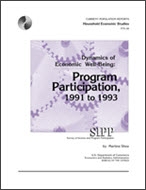Dynamics of Economic Well-Being: Program Participation, 1991 to 1993
Dynamics of Economic Well-Being: Program Participation, 1991 to 1993
Note: All demographic surveys, including the Survey of Income and Program Participation (SIPP), are affected by undercoverage of the population. This undercoverage results from missed housing units and missed persons within sample households. Compared to the level of the 1980 decennial census, overall undercoverage in SIPP is about 7 percent. Undercoverage varies with age, sex, and race. For some groups, such as 20 to 24 year old Black males, the undercoverage is as high as 27 percent compared to the census. It is important to note that the survey undercoverage is an addition to the decennial census undercoverage, which in 1980 was estimated to be about 1 percent overall and about 8.5 percent for Black males. The weighting procedures used by the Census Bureau partially correct for the bias due to undercoverage. However, its final impact on estimates is unknown.
Introduction
This report uses data from the SIPP to examine the participation in government assistance programs at a point in time and over a 32-month period. It presents data from the complete panel file of the 1991 SIPP which covers the time period from October 1990 through August 1993.
SIPP enables comparisons of rates of program participation and the amounts of benefits received among persons of different demographic and socioeconomic characteristics. It also can be used to study the distribution of spell durations. The panel file contains monthly information on the program participation status of individuals as well as on many other characteristics which can vary over the panel, such as family and labor force status. Efforts were made during the life of the panel to follow persons who moved to ensure that the sample remained representative of the noninstitutional population of the United States.
It should be noted that some longitudinal estimates presented here are based on persons who either were interviewed in all waves of the reference period or for whom imputed wave information exists.1 Insofar as persons with missing actual or imputed wave information differed in their experience of program participation from those who did not, these longitudinal estimates may be biased.
_______________
1 A ‘‘missing wave imputation’’ procedure was used for persons who missed an interview but had completed interviews before and after the missing wave.
Highlights
(The numbers in parentheses denote the 90-percent confidence intervals.)
- About 20.2 (+-1.3) million persons participated in a major assistance program on a long-term basis; i.e., all 24 months of 1991 and 1992, constituting 8.3 (+-0.5) percent of the population.
- The median length of time of receiving benefits from major means-tested assistance programs was 7.9 months during the 1991- to-1993 period, the same as during the 1990-to-1992 period.
- Total median monthly family benefits from Aid to Families With Dependent Children (AFDC), General Assistance, Supplemental Security Income (SSI), and food stamps were about $436 (+-5.8) in 1992.
- About 5.8 (+-0.5) percent of White persons participated long-term in major assistance programs, compared to 18.9 (+-2.5) percent of persons of Hispanic origin (who may be of any race) and 24.2 (+-1.4) percent of Black persons. Most long-term participants in means-tested assistance programs were White, 57.9 (+-3.2) percent, versus 36.2 (+-2.6) percent who were Black and 20.9 (+-2.7) percent who were Hispanic.
- Children were more likely to be long-term participants in major assistance programs than elderly persons and nonelderly adults, 13.4 (+-1.2) percent versus 11.1 (+-1.6) and 5.6 (+-0.5) percent.
- Unemployed workers and those out of the labor force, although not significantly different from one another, had substantially higher long- term participation rates in major assistance programs than persons employed either full or part time.
- The presence of a work disability increased the likelihood of long-term participation in major assistance programs from 3.8 (+-0.5) to 18.3 (+-2.3) percent.
- Persons in female-householder families were 22 times as likely as persons in married-couple families to have received AFDC or General Assistance and 13 times as likely to have received food stamps on a long-term basis.
Tables
Others in Series
Publication
Publication
Publication





